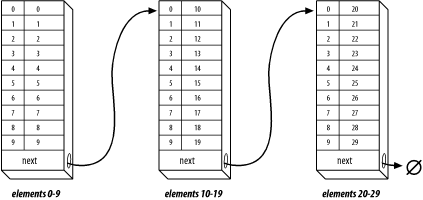23.6 A Program to Use Infinite Arrays
| I l @ ve RuBoard |
| The infinite array structure is shown in Figure 23-1. The program uses a simple linked list to store the elements of the array. A linked list can grow longer as needed (until you run out of memory). Each list element, or bucket, can store 10 numbers . To find element 38, the program starts at the beginning, skips past the first three buckets, and extracts element 8 from the data in the current bucket. Figure 23-1. Infinite array structure Example 23-4 contains the code for module ia.cpp . Example 23-4. ia/ia.cpp /******************************************************** * infinite-array -- routines to handle infinite arrays * * * * An infinite array is an array that grows as needed. * * There is no index too large for an infinite array * * (unless we run out of memory). * ********************************************************/ #include <iostream> #include <cstdlib> #include <assert.h> #include "ia.h" // get common definitions /******************************************************** * operator [] -- find an element of an infinite array * * * * Parameters * * index -- index into the array * * * * Returns * * Reference to the element in the array * ********************************************************/ int& infinite_array::operator [] (const unsigned int index) { // pointer to the current bucket class infinite_array *current_ptr; unsigned int current_index; // Index we are working with current_ptr = this; current_index = index; while (current_index >= BLOCK_SIZE) { if (current_ptr->next == NULL) { current_ptr->next = new infinite_array; if (current_ptr->next == NULL) { std::cerr << "Error:Out of memory\n"; exit(8); } } current_ptr = current_ptr->next; current_index -= BLOCK_SIZE; } assert(current_index >= 0); assert(current_index < sizeof(current_ptr->data)/sizeof(current_ptr->data[0])); return (current_ptr->data[current_index]); } /******************************************************** * ~infinite_array -- Destroy the infinite array * ********************************************************/ infinite_array::~infinite_array( ) { /* * Note: We use a cute trick here. * * Because each bucket in the infinite array is * an infinite array itself, when we destroy * next, it will destroy all that bucket's "next"s * and so on recusively clearing the entire array. */ if (next != NULL) { delete next; next = NULL; } } |
| I l @ ve RuBoard |
Practical C Programming, 3rd Edition
ISBN: 1565923065
EAN: 2147483647
EAN: 2147483647
Year: 2003
Pages: 364
Pages: 364
Authors: Steve Oualline